It seems to be really straightforward, it just happens. So if the data is of interest I will happily share..... Also maybe try Car Scanner Data recording feature to capture some of that in a file - I haven't personally used that feature so I'm not sure how well that works....
You are using an out of date browser. It may not display this or other websites correctly.
You should upgrade or use an alternative browser.
You should upgrade or use an alternative browser.
Please do - we love data in these corners of the forum.It seems to be really straightforward, it just happens. So if the data is of interest I will happily share.
Edit: oops
Last edited:
I believe it's simply related to ambient temperature. The cold weather front just arrived during the journey - temperature dropped from +6 °C to 2 °C. In the morning at steady +7 °C pure negative (except the first few minutes). Obviously need to keep on logging in becoming weeks/months.Already now over 50% of the trip cooler is not used. Another month and it will be close to 100% - maybe this helps cooler to last longer or changes the fault probability towards valve sticking rather than a blocked / leaking cooler.
Intriguing!
At first glance there seems to be a significant correlation with my observations of P0401 fault incidents.
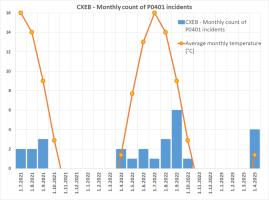
I believe it's simply related to ambient temperature.
Agreed. Actually looking at your cooler output temperature when exhaust was running through it I think there would be a significant risk of icing somewhere in the inlet manifold if the cooler would not be bypassed at low temperatures.
At first glance there seems to be a significant correlation with my observations of P0401 fault incidents.
Makes sense. If the cooler is somewhat clogged it wouldn’t restrict the flow when bypassed.
@coopso Thanks for the data! I took a peek into some of it and here's few selected plots and some thoughts at the end of the post.
Dataset: 2023-09-16 14-50-39.csv
Size: 178664 rows, < 90k samples of IDE07756 and IDE07757
Time span: From 53457 s to 75239 s - roughly 22k seconds
I've offset the plots to start from 0 seconds.
1. The big picture - full graph from 0 to 22k seconds
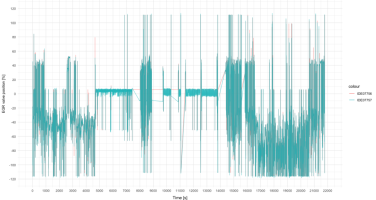
2. Zoom in 0 to 500 seconds
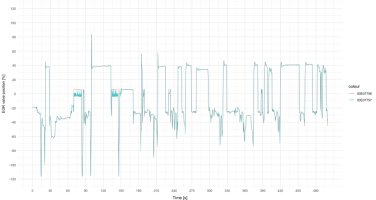
3. Zoom in 6000 to 6500 seconds
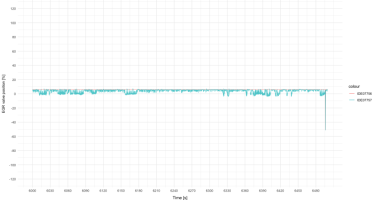
4. Zoom in 8000 to 8500 seconds
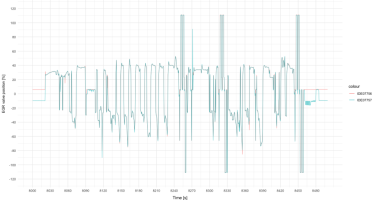
5. Zoom in 11500 to 12000 seconds
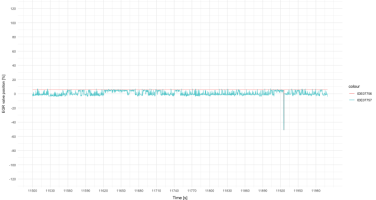
6. Zoom in 15000 to 15500 seconds
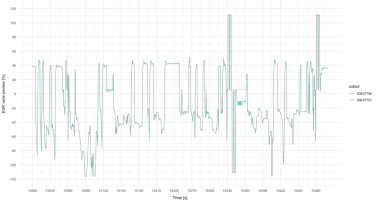
Overall, I don't see much new revelations. The actual position seems to follow specified position very well except for when EGR is closed - this much we already knew.
I'm little bit worried about the seemingly long regeneration in between 5000s to 7500s, followed by another one too soon at 9700s to 13700s seen in plot #1. Or at least I think they are regens - I don't know in what other conditions EGR would be commanded closed for such long periods. The latter regen seems to be interrupted by couple of stops (?) but continues when the trip continues. 40 minute regen sounds really long and as noted during that time EGR response is vague - it might let little bit of moist exhaust through the EGR cooler, perhaps eventually leading to clogging and EGR flow faults. However, personally I would investigate the long regens as a more pressing issue.
Dataset: 2023-09-16 14-50-39.csv
Size: 178664 rows, < 90k samples of IDE07756 and IDE07757
Time span: From 53457 s to 75239 s - roughly 22k seconds
I've offset the plots to start from 0 seconds.
1. The big picture - full graph from 0 to 22k seconds

2. Zoom in 0 to 500 seconds

3. Zoom in 6000 to 6500 seconds

4. Zoom in 8000 to 8500 seconds

5. Zoom in 11500 to 12000 seconds

6. Zoom in 15000 to 15500 seconds

Overall, I don't see much new revelations. The actual position seems to follow specified position very well except for when EGR is closed - this much we already knew.
I'm little bit worried about the seemingly long regeneration in between 5000s to 7500s, followed by another one too soon at 9700s to 13700s seen in plot #1. Or at least I think they are regens - I don't know in what other conditions EGR would be commanded closed for such long periods. The latter regen seems to be interrupted by couple of stops (?) but continues when the trip continues. 40 minute regen sounds really long and as noted during that time EGR response is vague - it might let little bit of moist exhaust through the EGR cooler, perhaps eventually leading to clogging and EGR flow faults. However, personally I would investigate the long regens as a more pressing issue.
Last edited:
Well, I'm afraid there are still a few unknowns how the EGR works. I'm confident I have observed the same - EGR staying at 0% without obvious reason - just need to find the log...Or at least I think they are regens - I don't know in what other conditions EGR would be commanded closed for such long periods.
Meanwhile, another fascinating behaviour - while was at standstill at traffic lights for some time (GREEN=vehicle speed) the EGR had fun by itself.
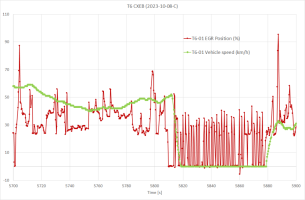
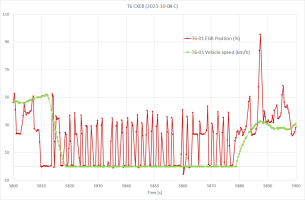
Most likely the same phenomena as described here:

Where’s This Bit From? . . . . Tonight’s Quiz
Its been a while . . . . . . . lets start with an easy one. "If you Know, you know" - LOL . Hmm. Need a larger pic..... can’t get enough detail....: :whistle:

Where’s This Bit From? . . . . Tonight’s Quiz
Its been a while . . . . . . . lets start with an easy one. "If you Know, you know" - LOL . Hmm. Need a larger pic..... can’t get enough detail....: :whistle:
Well, I'm afraid there are still a few unknowns how the EGR works. I'm confident I have observed the same - EGR staying at 0% without obvious reason - just need to find the log...
Meanwhile, another fascinating behaviour - while was at standstill at traffic lights for some time (GREEN=vehicle speed) the EGR had fun by itself.
View attachment 216573
View attachment 216575
Most likely the same phenomena as described here:

Where’s This Bit From? . . . . Tonight’s Quiz
Its been a while . . . . . . . lets start with an easy one. "If you Know, you know" - LOL . Hmm. Need a larger pic..... can’t get enough detail....: :whistle:www.t6forum.com

Where’s This Bit From? . . . . Tonight’s Quiz
Its been a while . . . . . . . lets start with an easy one. "If you Know, you know" - LOL . Hmm. Need a larger pic..... can’t get enough detail....: :whistle:www.t6forum.com
Clearly haunted for Halloween
That is really weird. I guess it could indeed be some kind of calibration / self test… although I have no idea what they could possibly try to achieve with that. And that clunking sound

Yes, or perhaps not... a snapshot from tonight's run... winter is obviously coming
View attachment 216022
Also seen in the graph above (I do not use coasting)
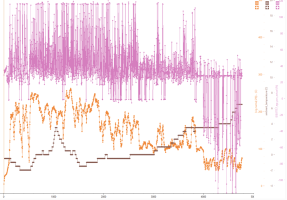
Indeed. Yesterday morning -2 or so and EGR didn't utilise cooling at fast mostly motorway run at all. Only last 20 mins or so, city driving with ambient temperature rising, did the cooler kick in. Orange is EGR cooler output temperature, not sure why asammdf messes it's axis title.
I had my car in for a regular service on Friday, they advised that they had seen a EGR error and recommended replacement. They're trustworthy, I'm sure they're not cynically exaggerating - but I've done so few miles (1,000 max) since my earlier measurements I wasn't sure that the EGR would have deteriorated that much.
Attached file from motorway journey today (I plugged in the dongle and started recording after about an hour of driving).
Grateful for any thoughts on the data. Thanks, Paul
Attached file from motorway journey today (I plugged in the dongle and started recording after about an hour of driving).
Grateful for any thoughts on the data. Thanks, Paul
Attachments
Flashing coil dash light and a few codes relating to EGR - insufficient flow, excessive flow, implausible signal, performance malfunction. Did the test with the engine switched off and with it idling, results from both tests showed that the valve doesn't close properly... new EGR valve time, what does the hive mind think?
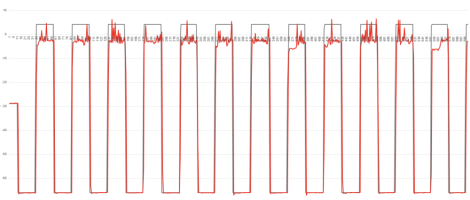

I had my car in for a regular service on Friday, they advised that they had seen a EGR error and recommended replacement. They're trustworthy, I'm sure they're not cynically exaggerating - but I've done so few miles (1,000 max) since my earlier measurements I wasn't sure that the EGR would have deteriorated that much.
Attached file from motorway journey today (I plugged in the dongle and started recording after about an hour of driving).
Grateful for any thoughts on the data. Thanks, Paul
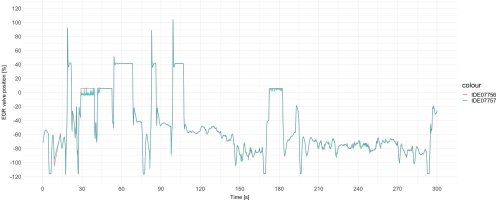
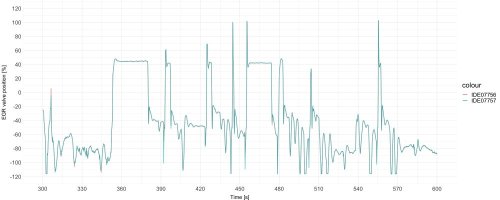
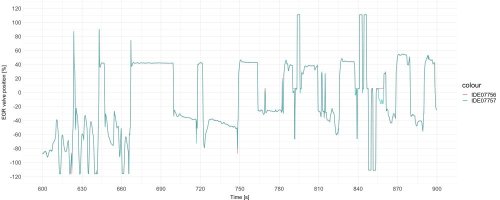
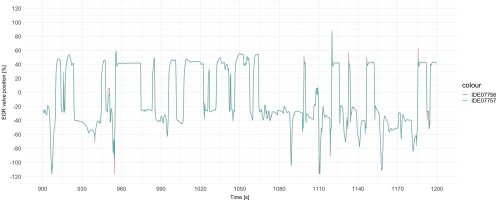
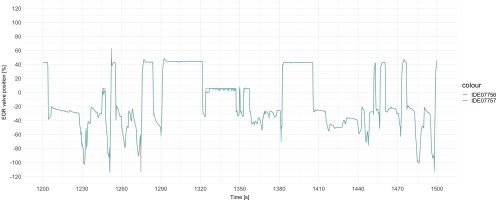
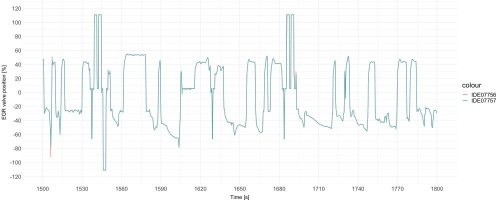
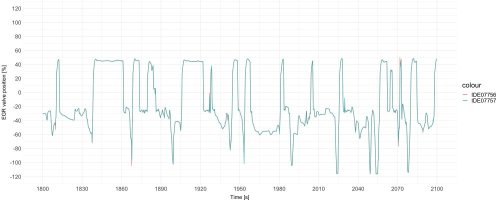
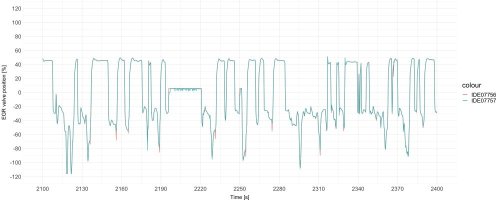
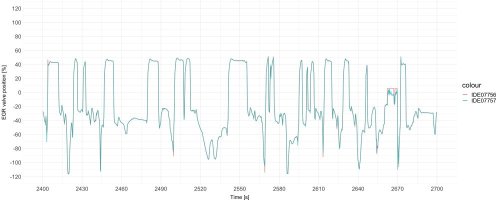
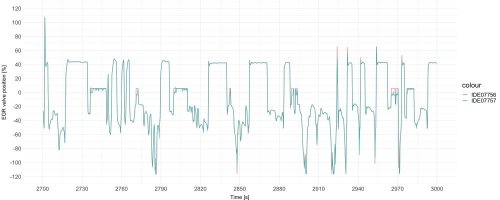
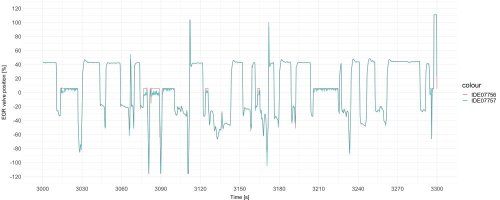
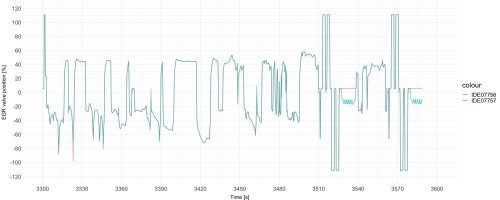
Here's it all graphed in 5 minute slices. There's few moments where there's little bit difference between commanded and actual value and they're again around when EGR is closed (close to 0). Especially at the very end of the last image. That said, most of the time EGR seems to work fine.
Did they say what the error they saw was?
Flashing coil dash light and a few codes relating to EGR - insufficient flow, excessive flow, implausible signal, performance malfunction. Did the test with the engine switched off and with it idling, results from both tests showed that the valve doesn't close properly... new EGR valve time, what does the hive mind think?
View attachment 230905
Looks like that based on this test. Especially if the results look identical with engine not running vs engine running - testing with engine not running rules out any pressure issues affecting the valve position.
Thanks so much for your help again! Much appreciated........There's few moments where there's little bit difference between commanded and actual value and they're again around when EGR is closed (close to 0). Especially at the very end of the last image. That said, most of the time EGR seems to work fine.
Did they say what the error they saw was?
Yes codes seen (and reset) by the garage were:
Code:
P046C00 - Implausible signal
P245700 - Exhaust Gas Recirculation: engine power too low
Code:
P046C00: EGR Sensor "A" Circuit Range/Performance
Exhaust Gas Recirculation Sensor "A" Circuit, Range/Performance
P046C00: EGR Sensor "A" Circuit Range/Performance
Status: Pending, Confirmed, Test failed since last DTC clear, Test not completed during this operation cycleI have what looks to be a reasonable quote for EGR blanking and software EGR delete but it is definitely a high enough cost to make me have a pause for thought.... Is there any way to make an educated decision on spending the money now or later?
If it's just guess work then that's fine, but if there is a high probability that the problem is an annoyance rather than something that is damaging the engine - or a low probability for that matter - that would be very helpful to know.
I'm doing about 7,000 miles a year, currently on 150,000. I got a clean bill of health from a millers oil test (in September 2022 which was 4,000 miles after the previous full service) except for soot level:
The only other comment I could make is that the soot is a little high, soot becomes an abrasive contaminant at higher levels thus we warn at 1% and declare a critical level at 2%. Your sample, at 0.8%, is within the acceptable range but the miles on the oil is given as 4245; since contaminants can reasonably be expected to increase with mileage, the result would be 1.9% at 10,000 miles, almost at the critical level. High soot in oil is a symptom of sticking EGR valves but could have various other causes as well.
I've attached two more sets of data from the very long drive I did on Friday. Looks to me like the same type of behaviour.
Attachments
Last edited:
Here’s another thread with the same code and showing the freeze frame. I think it confirms P046C00 specifically refers to detected difference in the EGR valve specified and actual position.

 www.t6forum.com
www.t6forum.com

EGR Sensor 'A' (EGR Sensor '1')
Hi there from not-so sunny Cornwall atm. Can any of you good people shed the light on this, I have seen it mentioned on previous posts but it never seems to get answered: I have a fault code P046C00 EGR SENSOR 'A" (1) My van It is not in limp mode and seems to be driving fine but can anyone just...
Thanks, looks to be the same or similar, yes.Here’s another thread with the same code and showing the freeze frame. I think it confirms P046C00 specifically refers to detected difference in the EGR valve specified and actual position.

EGR Sensor 'A' (EGR Sensor '1')
Hi there from not-so sunny Cornwall atm. Can any of you good people shed the light on this, I have seen it mentioned on previous posts but it never seems to get answered: I have a fault code P046C00 EGR SENSOR 'A" (1) My van It is not in limp mode and seems to be driving fine but can anyone just...www.t6forum.com
I'll keep an eye on that thread.
I also finally downloaded the DPF monitor app and see that my DPF has 29.9g of oil ash residue, in case that's relevant.
Last edited:
I also finally downloaded the DPF monitor app and see that my DPF has 29.9g of oil ash residue, in case that's relevant.
That’s good and very low for your mileage - probably long trips have helped significantly. The limit is 110g so at least in terms of ash you still have loads of DPF lifetime left.

Oil ash residue
Hi I did try and search apologies in advance if this has been covered before. I have a 204 engine 2016 plate. Just used the VAG dpf app for the first time and I have 24.8g of oil ash residue at 36k miles. I have no idea if this is a normal amount and even if it's calculated on an actual...
I have what looks to be a reasonable quote for EGR blanking and software EGR delete but it is definitely a high enough cost to make me have a pause for thought.... Is there any way to make an educated decision on spending the money now or later?
If it's just guess work then that's fine, but if there is a high probability that the problem is an annoyance rather than something that is damaging the engine - or a low probability for that matter - that would be very helpful to know.
This is a difficult question and I don’t have a definite answer.
As I said in the other thread, I haven’t seen conclusive evidence on when exactly EGR should be changed (or deleted). But as the valve does not close completely during regens the problem is only going to get worse with accelerated rate. Meanwhile more soot is going to accumulate to EGR cooler and to the inlet manifold. Also as the oil test results confirmed, soot is making it’s way to oil thus reducing it’s quality early.
If it was my own van, I would probably eat it and change the EGR as preventive maintenance. If you decide to stick with it for the time being, more frequent oil changes would be prudent to dodge the effects of abrasion wearing the engine.
Hi @coopso can I ask you a favourite - could you please add another custom sensor to CarScanner to get some additional data on top of the EGR valve positions?
I'm interested into looking into EGR output temperature, especially during regens when the EGR valve is supposed to be closed. Here's the details for CarScanner:
No special hurry with this one, I would be grateful though!
I'm interested into looking into EGR output temperature, especially during regens when the EGR valve is supposed to be closed. Here's the details for CarScanner:
Code:
Name: IDE07729-egr-temperature
Short name: IDE07729
Command: 22447B
Header: 7E0
Decode scheme: Formula
Formula: ShortSigned(A,B)*0.1
Minimum: -500
Maximum: 500
Unit: CNo special hurry with this one, I would be grateful though!
No worries, yes. I'm off to get my EGR delete next week, but will record the data for at least that journey and post it here.Hi @coopso can I ask you a favourite - could you please add another custom sensor to CarScanner to get some additional data on top of the EGR valve positions?
I'm interested into looking into EGR output temperature, especially during regens when the EGR valve is supposed to be closed. Here's the details for CarScanner:
Code:Name: IDE07729-egr-temperature Short name: IDE07729 Command: 22447B Header: 7E0 Decode scheme: Formula Formula: ShortSigned(A,B)*0.1 Minimum: -500 Maximum: 500 Unit: C
No special hurry with this one, I would be grateful though!
Earlier timestamp is the 2 stage journey before EGR removal. Later is the 1 stage journey after EGR removal. EGR was blanked both sides and mapped out.Hi @coopso can I ask you a favourite - could you please add another custom sensor to CarScanner to get some additional data on top of the EGR valve positions?
I'm interested into looking into EGR output temperature, especially during regens when the EGR valve is supposed to be closed. Here's the details for CarScanner:
Code:Name: IDE07729-egr-temperature Short name: IDE07729 Command: 22447B Header: 7E0 Decode scheme: Formula Formula: ShortSigned(A,B)*0.1 Minimum: -500 Maximum: 500 Unit: C
No special hurry with this one, I would be grateful though!
Curious to see if you find anything useful or interesting!
Attachments
Similar threads
- Replies
- 62
- Views
- 6K
- Replies
- 7
- Views
- 799
- Replies
- 17
- Views
- 3K
- Replies
- 8
- Views
- 1K

